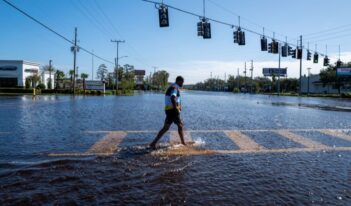
Certain communities may face disproportionate harms in the wake of natural disasters.
Low-income communities and communities of color face disproportionate environmental harms. Industrial sites, such as coal plants and refineries, are up to 54 percent more likely to be located in predominantly black neighborhoods and 35 percent more likely in neighborhoods afflicted with high levels of poverty.
In a recent paper, Professor Brie Sherwin argues that flooding due to hurricanes only exacerbates the disparate effects of industrial pollution. Specifically, Sherwin asserts that inadequate regulations and procedures both before and after storms contribute to disproportionate harms to low-income communities and communities of color in the wake of natural disasters.
Flooding aggravates zoning and industrial pollution problems. When floods cause leaching and spills from industrial sites containing toxins and pollutants, the substances cause increased risks of health hazards in the surrounding communities. Because industrial sites are reportedly more often placed near low-income communities and communities of color, these communities also suffer the effects of toxic spills caused by floods.
Sherwin uses Hurricane Harvey to demonstrate a recent example of how a combination of flooding, industrial pollution, and inadequate governmental response disproportionately impacted communities of color and low-income communities.
When Hurricane Harvey hit Houston in 2017, floodwater mixed with untreated sewage overflow, hazardous spills, and toxic releases to create dangerous conditions. Water and sediment samples in flooded homes revealed levels of E. coli that were 135 times higher than considered safe, as well as elevated levels of lead and arsenic, Sherwin explains.
Affected communities had difficulties leaving the contaminated areas due to lack of adequate assistance, Sherwin argues. She explains that “the percentage of the population living in poverty in particular areas is a direct measure of that community’s ability to evacuate and locate alternate or new housing after a hurricane.” The people hit hardest by the storms are low-income communities, who then receive inadequate assistance after the damage is done, Sherwin asserts.
Although the floods affected affluent areas as well as poor areas, minority and low-income residents received help less quickly than white and higher income residents, Sherwin argues. One year after the storm, homes belonging to black and Hispanic residents were reportedly between 1.8 to 2.5 times more likely to still be damaged than homes belonging to white residents. Similarly, 50 percent of lower income residents reported not receiving the help they needed compared to 32 percent of higher income residents.
In addition, over 80 percent of residents did not have flood insurance because they could not afford it. Some people were denied Federal Emergency Management Agency (FEMA) assistance because they did not have the legally required flood insurance. Even residents who did receive FEMA assistance reportedly received only an average of $4,300 by May of 2018.
Sherwin recommends policy changes both before and after storms hit to address disproportionate flooding impacts more effectively.
Cities and states continuously show a failure to regulate before the floods, she argues. Cities have shown resistance to using scientifically created reports outlining flood risks, and in some cases even outlaw the use of the reports. These cities instead favor development, often making flooding worse by continuing to build in floodplains and paving over green areas, reducing the land’s ability to absorb floodwater, Sherwin explains.
In addition, the federal government subsidizes flood insurance through the National Flood Insurance Program. Sherwin argues that this “creates an incentive for residents to remain in and continue to build in floodplains due to the artificially cheap insurance.” Sherwin points out, though, that many low-income and minority communities do not want to move due to either the cultural and historical value of the community or an inability to afford housing elsewhere.
Sherwin recommends that cities change their land use restrictions to account for changes in floodplains. In Houston, the chemical plant that reportedly released over 34,000 pounds of highly toxic chemicals was located in a floodplain that the government claimed had “a .02 percent chance of flooding in any year.” The release during Hurricane Harvey was reportedly the third time in three years that the facility had chemical leaks it attributed to flooding. Sherwin argues that cities should use the most recent floodplain data for planning.
Sherwin recognizes, however, that banning development in areas that are now floodplains presents a serious challenge. Restricting housing in these areas could displace many low-income communities and communities of color, she explains.
Sherwin also advocates for including flood risks and the billions of dollars of flood damage into any future cost-benefit analysis for development. She proposes several initiatives, such as “comprehensive emergency action plans,” better notification systems to alert citizens of potential harms, training for emergency managers and first responders, and a dialogue between community leaders and regulators to encourage consideration of community needs.
Sherwin acknowledges, though, that “these solutions could be considered a step in the right direction, but still do not account for low-income communities that are often hit hardest by the flooding.”



